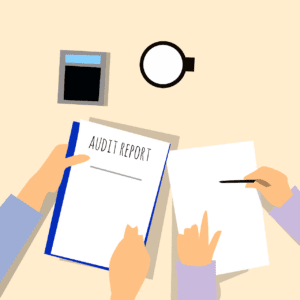
In today’s digital age, organizations face many cyber threats and regulatory requirements. Safeguarding sensitive data, maintaining compliance, and ensuring operational resilience have become paramount. Organizations turn to various cybersecurity audits and frameworks tailored to their needs to achieve these objectives. This comprehensive guide explores the diverse world of cybersecurity audits and the frameworks underpinning them.
1. Cybersecurity Audit Frameworks: Protecting the Digital Fortress
Example: CIS Top 18 Controls
Cybersecurity audit frameworks are the foundation upon which organizations build their defenses against evolving cyber threats. These frameworks provide a structured approach to identifying vulnerabilities, mitigating risks, and ensuring compliance with industry regulations. They offer actionable guidance for organizations to enhance their cybersecurity posture.
Strengths:
- Data-Driven Approach: Frameworks like the CIS Controls rely on real-world cyberattack data, ensuring relevance.
- Customization: Tailor controls to your specific needs and risk profile.
- Practicality: These frameworks provide actionable recommendations for immediate security improvements.
Weaknesses:
- Resource Intensity: Implementing all controls can be resource-intensive, particularly for smaller organizations.
- Complexity: Some controls may require advanced technical expertise.
Statistics:
- According to a CIS study, organizations that implement all 18 controls can reduce their risk of a cyberattack by 85%.
- A survey by Ponemon Institute found that organizations following cybersecurity frameworks experience 20% less financial damage from a data breach than those without a framework.
2. Governance and Compliance Audits: Upholding Ethical Practices
Example: GDPR Compliance Audit
Governance and compliance audits assess an organization’s adherence to regulatory requirements and internal policies. These audits ensure that an organization’s practices align with industry standards and legal obligations, promoting transparency, accountability, and ethical conduct.
Strengths:
- Accountability: Ensures adherence to legal and regulatory obligations.
- Transparency: Provides insight into organizational compliance.
- Ethical Conduct: Promotes responsible and ethical business practices.
Weaknesses:
- Tailoring Required: Organizations must customize audits to their specific needs.
- Detailed Implementation: Audits provide high-level guidance, necessitating detailed implementation plans.
Statistics:
- Organizations underwent compliance audits after implementing the EU’s General Data Protection Regulation (GDPR). In 2020, the European Data Protection Board reported over 160,000 GDPR-related cases and investigations.
- The Information Systems Audit and Control Association (ISACA) states that organizations with strong governance and compliance practices are 20% more likely to achieve their strategic goals.
3. Risk Assessment Audits: Identifying Potential Hazards
Example: Enterprise Risk Assessment
Risk assessment audits are designed to identify and evaluate potential risks impacting an organization’s operations. These audits assess various risks’ likelihood and potential impact, helping organizations prioritize risk mitigation strategies.
Strengths:
- Proactive Risk Management: Identifies vulnerabilities before they can be exploited.
- Informed Decision-Making: Supports data-driven risk mitigation strategies.
- Insights into Vulnerabilities: Provides a clear picture of areas requiring attention.
Weaknesses:
- Resource Intensive: Conducting comprehensive risk assessments may require significant effort.
- Specialized Knowledge: An in-depth understanding of risk management is necessary for effective implementation.
Statistics:
- A risk assessment conducted by IBM found that the average cost of a data breach in 2021 was $4.24 million, highlighting the importance of identifying and mitigating risks.
- According to the World Economic Forum’s Global Risks Report, cyberattacks are among the top global risks, with a 23.1% likelihood of occurrence over a ten-year horizon.
4. Privacy Audits: Protecting Personal Data
Example: HIPAA Privacy Audit
Privacy audits focus on assessing an organization’s compliance with privacy laws and regulations, particularly protecting personal and sensitive data. These audits ensure the confidentiality and privacy of individuals’ information.
Strengths:
- Data Protection: Safeguards personal and sensitive data.
- Compliance Assurance: Demonstrates commitment to privacy regulations.
- Customer Trust: Builds trust with customers and stakeholders.
Weaknesses:
- Specialization: Privacy audits focus primarily on data protection and may require additional frameworks for broader cybersecurity coverage.
- Documentation Intensive: Privacy audits involve detailed documentation and processes like other audits.
Statistics:
- The U.S. Department of Health and Human Services (HHS) conducted HIPAA audits, resulting in settlements with healthcare organizations. In 2021, HHS reached settlements totaling $12.2 million for HIPAA violations.
- A survey by Cisco found that 32% of organizations reported a data breach that resulted in customer loss after failing to protect sensitive customer data adequately.
5. Business Continuity and Disaster Recovery Audits: Ensuring Resilience
Example: FEMA’s National Flood Insurance Program (NFIP) Audit
Business continuity and disaster recovery audits evaluate an organization’s preparedness to respond to unexpected disruptions. They assess the effectiveness of continuity plans, data backup strategies, and recovery procedures to maintain critical business functions during adverse conditions.
Strengths:
- Operational Resilience: Ensures essential functions can continue during disruptions.
- Recovery Assurance: Validates recovery plans and strategies.
- Risk Mitigation: Identifies vulnerabilities that may impact business continuity.
Weaknesses:
- Resource and Planning Intensive: Establishing robust continuity and recovery plans can be resource-intensive.
- Evolving Threats: Audits must adapt to evolving threats and technologies.
Statistics:
- FEMA conducts audits of organizations participating in the NFIP to ensure they have effective flood insurance policies and disaster recovery plans. In 2021, NFIP paid out over $7.2 billion in claims.
- The Disaster Recovery Preparedness Council’s annual survey revealed that 73% of organizations worldwide are unprepared for a disaster, highlighting the need for robust business continuity and disaster recovery audits.
6. Cloud Security Audits: Trust in the Cloud
Example: AWS Well-Architected Review
Cloud security audits evaluate security measures and controls in cloud computing environments. With the increasing adoption of cloud services, these audits ensure the security and integrity of data and applications hosted in the cloud.
Strengths:
- Cloud Expertise: Provides specialized guidance for securing cloud environments.
- Customization: Allows tailoring controls to specific cloud providers and deployment models.
- Transparency: Offers visibility into cloud provider security controls.
Weaknesses:
- Niche Focus: Primarily suitable for organizations heavily reliant on cloud services.
- Rapid Evolution: Cloud technologies evolve rapidly, requiring continuous audit updates.
Statistics:
- Amazon Web Services (AWS) offers a Well-Architected Review to assess the security, reliability, performance, and cost-effectiveness of cloud architectures. AWS reported that customers who follow well-architected principles experience 29% fewer security incidents.
- Gartner predicts that by 2025, 80% of enterprises will shut down their traditional data centers in favor of cloud infrastructure, emphasizing the importance of cloud security audits.
7. Industrial Control Systems (ICS) Security Audits: Protecting Critical Infrastructure
Example: Stuxnet Attack on Iran’s Nuclear Program
ICS security audits are specialized assessments of cybersecurity measures for industrial automation and control systems. They are critical for industries like manufacturing and energy, where ICS vulnerabilities can have severe consequences.
Strengths:
- Critical Infrastructure Protection: Ensures the security of essential systems.
- Industry-Specific Guidance: Addresses the unique cybersecurity challenges of critical infrastructure.
- Vulnerability Assessment: Identifies weaknesses in ICS security measures.
Weaknesses:
- Specialized Knowledge: Requires expertise in industrial control systems and their security.
- Complex Environment: The interconnected nature of ICS can make audits complex.
Statistics:
- The Stuxnet attack of 2010, targeting Iran’s nuclear program through its ICS, demonstrated the potential consequences of ICS vulnerabilities. It highlighted the importance of ICS security audits in critical infrastructure sectors.
- The Cybersecurity and Infrastructure Security Agency (CISA) reported a 74% increase in cyber incidents targeting critical infrastructure in 2020.
8. Federal Information Security Audits: Government Cybersecurity Compliance
Example: FISMA Compliance Audit
In 2021, the U.S. Government Accountability Office (GAO) conducted FISMA audits and identified weaknesses in federal agencies’ information security programs. These audits aim to strengthen cybersecurity across government agencies.
Strengths:
- Government Compliance: Ensures adherence to federal cybersecurity requirements.
- Data Protection: Safeguards government data and critical systems.
- Security Assurance: Demonstrates a commitment to secure government operations.
Weaknesses:
- Federal Focus: Specific to government entities and contractors working with the government.
- Stringent Requirements: Compliance with federal regulations can be rigorous.
Statistics:
- In 2020, the Office of Management and Budget (OMB) reported a 250% increase in federal cybersecurity incidents, underscoring the need for rigorous federal information security audits.
9. Healthcare Compliance Audits: Protecting Patient Data
Example: HIPAA Security Rule Audit
The U.S. Department of Health and Human Services’ Office for Civil Rights (OCR) conducts HIPAA Security Rule audits. In 2020, OCR settled HIPAA cases, resulting in penalties totaling $13.5 million.
Strengths:
- Industry Relevance: Tailored to the unique cybersecurity challenges of healthcare.
- Regulatory Alignment: Streamlines compliance efforts with healthcare privacy and security regulations.
- Patient Data Protection: Ensures the security and privacy of patient information.
Weaknesses:
- Niche Focus: Primarily suitable for healthcare organizations.
- Implementation Complexity: Healthcare-specific cybersecurity measures can be complex.
Statistics:
- According to the “2021 Healthcare Data Breach Report” by Fortified Health Security, there were 642 reported healthcare data breaches in 2020, exposing 24.1 million records.
These examples and statistics highlight the critical role of different audit types in addressing specific cybersecurity and compliance challenges. Organizations must leverage the insights gained from these audits to strengthen their security posture, protect sensitive data, and effectively navigate the evolving landscape of cyber threats and regulations.


